There are 15 species of turtles in Kansas thanks to the specialized climate which allows such a diversity of animals. The state has vast plains, forests, wetlands, hills, and valleys, and plenty of waterways for turtles to live in.
You may find snapping turtles, box turtles, sliders, softshell turtles, and many more when you’re out in the Kansas wilderness. Let’s find out what species call the Sunflower State home.
Table of Contents
Snapping Turtles in Kansas
1. Common Snapping Turtle
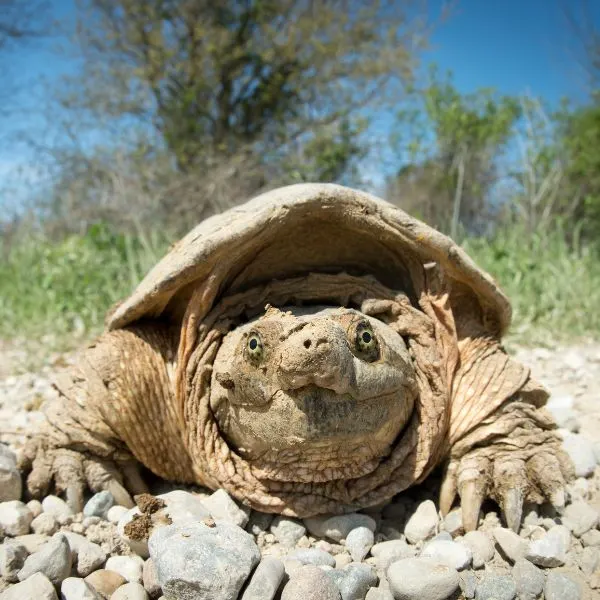
- Experience level: Intermediate to Expert
- Family: Chelydrida
- Scientific Name: Chelydra Serpentina
- Other Names: Snapping Turtle, Snapper, Eastern Snapping Turtle
- Average Adult Size: 8 to 20 inches
- Life Span: 30 – 50 years
- Average Price Range: Approximately $40 to $120
- Conservation Status: Least concern
The Common Snapping turtle lives in waters all across Kansas, although it’s more common in the eastern half of the state. They prefer waters that don’t have much current such as lakes, ponds, oxbows, slow rivers, and streams.
Adults are much less active than juveniles and prefer to spend their time at the bottom of the water. Even when basking they only swim to the surface of the water.
Snapping turtles will come out of the water when they need to find a place to lay their eggs, or while in the search of better “real estate.” In the water, these large turtles will hide or get away from people, but on land, they can become rather aggressive.
Snapping turtles have a dark brown, olive, or black carapace (upper shell) that may be covered in mud or algae. Their plastron (lower part of the shell) is very small and nearly white. Their skin ranges from pale yellow to nearly black.
These turtles have large limbs with thick claws, a long neck, and broad heads. Their tail is long and ridged.
Food preferences include mostly meat sources such as fish, frogs, tadpoles, crayfish, small turtles, and the occasional waterfowl. They have a bad reputation for eating ducklings and other small waterbirds, but in truth, they rarely go after birds. The Snapping turtle occasionally eats algae and other plant material.
2. Alligator Snapping Turtle

- Experience level: Expert
- Family: Chelydrida
- Scientific Name: Macrochelys temminckii
- Common Name: Loggerhead Snapper
- Average Adult Size: 13-30 inches
- Life Span: 30 – 50 years
- Average Price Range: Approximately $50 to $300
- Conservation Status: Threatened
The Alligator Snapping turtle is the Common Snapping turtle’s bigger, meaner cousin. They are the largest freshwater turtle in all of North America.
In the water, they are pretty docile, but on land, they are ill tempered. They will hiss, open their wide, sharp mouths, and try to bite anything that gets too close. With a bite force of 1,000 pounds, you don’t want to be on the receiving end.
These relics of the dinosaur age have thick, pointed shells, huge heads, long tails, big legs, and fleshy spikes all over their skin. If you see this turtle out of the water, the best thing you can do is just observe from a distance. It doesn’t need any help getting where it wants to go.
Most of the time, the Alligator Snapping turtle lounges at the bottom of muddy waters with its mouth open. On their tongue is a little appendage that looks like a worm. They wiggle it in the water to attract fish, frogs, and other prey.
Alligator Snapping turtles are quite rare in Kansas and they prefer to live in slow moving or stagnant waters of wetlands, swamps, bogs, and slow moving lakes.
Once they were pretty common across the southern states, but hunting and habitat loss have reduced them to a threatened species.
These turtles are difficult to find in the pet trade because they are very aggressive, grow quite large, and there are several states where it’s illegal to own or sell them.
Musk Turtles in Kansas
3. Eastern Musk Turtle
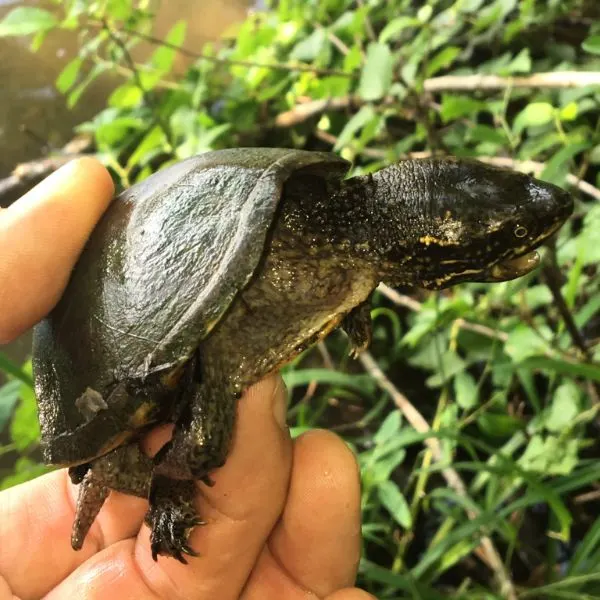
- Experience Level: Intermediate
- Family: Kinosternidae
- Scientific Name: Sternotherus odoratus
- Other Names: Common Musk turtle, Stinkpot
- Adult Size: 4 to 5 inches (10 to 12.5 cm)
- Life Span: 30 to 50 years
- Average Price Range: $30 to $120
- Conservation Status: Least concern
The Common Musk turtle, also known as the Eastern Musk turtle or “stinkpot” inhabits the eastern areas of Kansas. They prefer shallow waters with muddy bottoms and a lot of vegetation.
They aren’t the greatest swimmers and will often walk along the bottom of the water, or climb up on vegetation to reach the surface of the water. They are so good at climbing that they often climb branches of trees that dip into the water’s surface.
Let’s address their nickname, the Stinkpot. This turtle and other Musk turtle species have glands that can squirt out an oily substance with a disgusting stench when they are threatened. Think of these reptiles as the skunks of the turtle world.
They will also try to bite if your hand gets too close to the mouth.
These odiferous little turtles have a domed, unmarked brown or olive shell. Their skin is drab and dark colored as well, but they do have white stripes on either side of their head.
Common Musk turtles eat crayfish, mollusks, fish, insects, and some plant matter.
Mud Turtles in Kansas
4. Yellow Mud Turtle

- Experience level: Intermediate
- Family: Kinosternidae
- Scientific Name: Kinosternon flavescens
- Common Name: Mud Turtle, Yellow Mud Turtle
- Average Adult Size: 5 – 7 inches
- Life Span: 40 years
- Average Price Range: Approximately $80 to $300
- Conservation Status: Conservation Status: Federally listed as least concern, but threatened or endangered in most states.
Yellow Mud turtles can primarily be found in the western half of Kansas. They enjoy still and slow-moving bodies of water, such as lakes, ponds, and drainage ditches, as these tend to have muddy bottoms.
When the weather gets too cold, these turtles will burrow into the mud and hibernate.
The Yellow Mud turtle tends to have yellowish skin, especially on the underside of the head, neck, and limbs. The carapace can be drab yellow, tan, or brown and is non-descript.
Though mostly aquatic, the Yellow Mud turtle will come to land to find food sometime. They eat mostly meat sources such as fish, tadpoles, frogs and amphibians, insects, ticks, turtle eggs, mollusks, and carrion. They also eat some vegetation but it’s rare.
Painted Turtles in Kansas
5. Eastern Painted Turtle

- Experience level: Beginner
- Family: Emydidae
- Scientific Name: Chrysemys picta
- Common Name: Painted Turtle
- Average Adult Size: 4 – 10 inches
- Life Span: 30 – 50 years
- Average Price Range: Between $30 to $150
- Conservation Status: Least Concern
Painted turtles are the most widespread species found in the United States. There are 4 subspecies found across the states. Painted turtles have yellow, white, orange, or red stripes on their head and body.
The Eastern Painted turtle has a smooth olive green or dark brown carapace, and a tan or pale yellow plastron. They have yellow stripes on skin that’s dark green or black, and two larger yellow dots behind their eyes.
The Eastern Painted turtle prefers shallow waters such as marshes, lakes, ponds, and slow moving streams with a lot of aquatic vegetation.
Adult Painted turtles are mostly herbivorous, but occasionally eat fish, insects, or other sources of meat. Juveniles are mostly carnivorous and transition as they get older. Since their tongue is fused to the bottom of their mouth, Painted turtles have to be in the water to swallow their food.
Map Turtles in Kansas
6. Northern Map Turtle
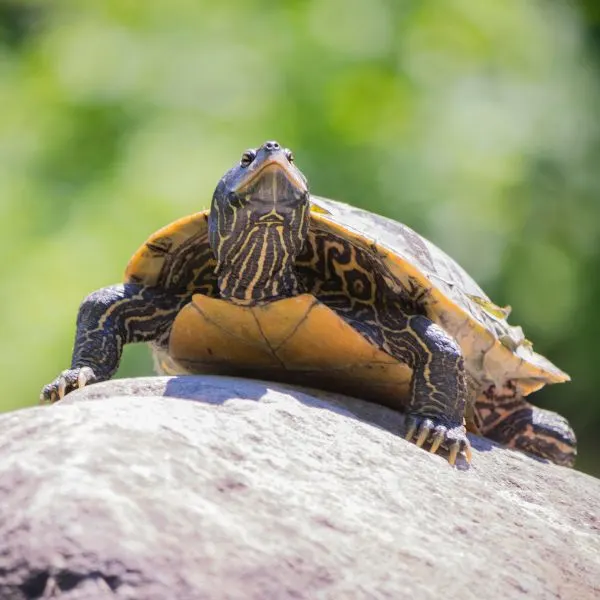
- Experience Level: Beginner
- Family: Emydidae
- Scientific Name: Graptemys geographica
- Other Name: Common map turtle
- Adult Size: Between 4 and 10 ½ inches
- Life Span: 15 to 20 years
- Average price range: Between $20 and $60
- Conservation Status: Least concern
The Common Map turtle (a.k.a. northern map turtle) got its name because the carapace has patterns on the scutes that resemble a map. The upper shell is grey, to green and has a keel (ridge) running down the middle.
As the turtle grows, the keel wears down and becomes less prominent. They also have serrated edges on the back of the shell.
The Northern Map turtle’s body is dark green to dark brown and covered with lots of thin stripes. These stripes are pale yellow or almost white in color.
They prefer larger bodies of water such as rivers and lakes. They will inhabit ponds, but they like waterways that have plenty of space and basking spots. These turtles will often share basking spots with other turtles.
Females are typically much larger than males and can eat items such as mussels and clams, while the smaller male has to stick to softer foods such as fish and insects.
7. Ouachita Map Turtle

- Experience Level: Beginner
- Family: Emydidae
- Scientific Name: Graptemys ouachitensis
- Other Names: Southern Map turtle
- Adult Size: 3.5 to 10 inches (9 to 25.5 cm)
- Life Span: 15 to 20 years
- Average Price Range: $40 to $100
- Conservation Status: Least concern
The Ouachita Map turtle looks very similar to other species of map turtles. One way to differentiate between the two is by comparing their heads. The Ouachita (pronounced “wah-cheetah”) Map turtle has large white or yellow spots behind their eyes.
They like the same type of habitat and like to bask together. The Ouachita Map turtle has a more varied diet than other map turtles though. They will eat almost anything in the water. They feed on fish, crayfish, mollusks, algae, plant matter, insects, and carrion.
Though they love to bask in the warm sun, this ever alert turtle will quickly slip into the water at the first sign of a disturbance. Sometimes all it takes is one to jump into the water for the rest to follow.
8. False Map Turtle
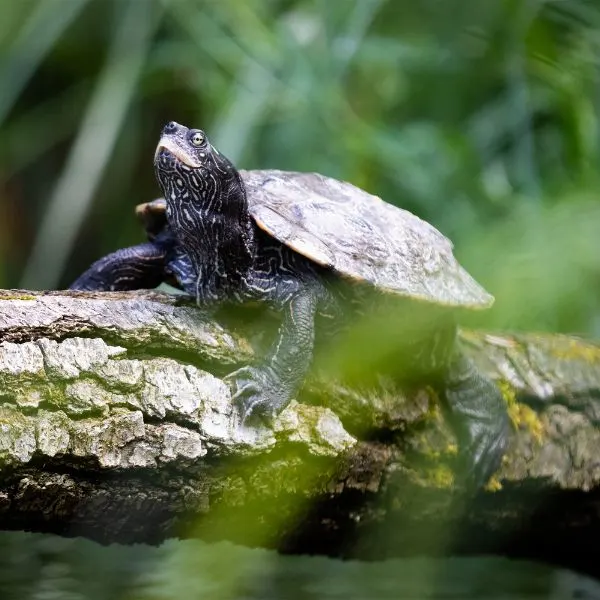
- Experience Level: Beginner
- Family: Emydidae
- Scientific Name: Graptemys pseudogeographica
- Other Names: Sawback turtle
- Adult Size: 3.5 to 10.5 inches
- Life Span: 30 to 50 years
- Average Price Range: $6 to $40
- Conservation Status: Least concern
The False Map turtle isn’t a different species of turtle trying to look like a map turtle, it’s actually a true species of map turtle. Why it has such a negative name is beyond me, but I wouldn’t try to follow the map lines on its shell.
Bad jokes aside, the False Map turtle looks very similar to other Map turtles. They have a midline ridge along the carapace, they have the swirls and patterns like other Map turtles and saw-toothed ridges at the back. In fact, this turtle is nicknamed the “Sawback turtle” because of that characteristic.
To tell False Map turtles apart from their cousins look for a backward “L” behind each eye, and several stripes that run up to the eye. Since these turtles in the wild are very skittish, you may never be able to get that close.
False Map turtles are generally carnivorous though they will occasionally eat some aquatic vegetation. Insects and larvae, crustaceans, freshwater clams, and fish are some of their favorite foods.
You may find False Map turtles in large rivers and streams. They rarely leave the water except to bask on logs or rock outcroppings, and to lay their eggs.
Cooters in Kansas
9. Eastern River Cooter

- Experience Level: Beginner to Intermediate
- Family: Emydidae
- Scientific Name: Pseudemys concinna concinna
- Other Names: River Cooter
- Adult Size: Between 8 and 12 inches
- Life Span: Between 20 and 40 years
- Average Price Range: $20 to $50
- Conservation Status: Special concern
River Cooters likely got their unusual name from the African word “Kuta” which means – you guessed it – “turtle.”
The River Cooter’s shell is usually dark green or brown, with a lot of markings that tend to fade as the turtle ages. The head and limbs have yellowish stripes. River Cooters look very similar to Sliders and Painted turtles, but Cooters usually get bigger.
Their plastron is yellow to reddish orange with a dark pattern along the middle line.
These turtles spend a lot of time underwater which makes it difficult to study them. One of the reasons they can stay underwater for such long periods is because they can extract oxygen from the water through their cloaca. Yes, River Cooters can breathe through their butts.
Cooters do bask, but they are reclusive and will run back to the water if they see anything that could be perceived as a threat. They may be around, but you may never see them because of their shy habits.
As their name suggests, you’ll find these turtles in large rivers, lakes, and streams, especially where there is a lot of vegetation. Their diet is mostly aquatic vegetation, though juveniles eat more protein sources.
Box Turtles in Kansas
10. Ornate Box Turtle
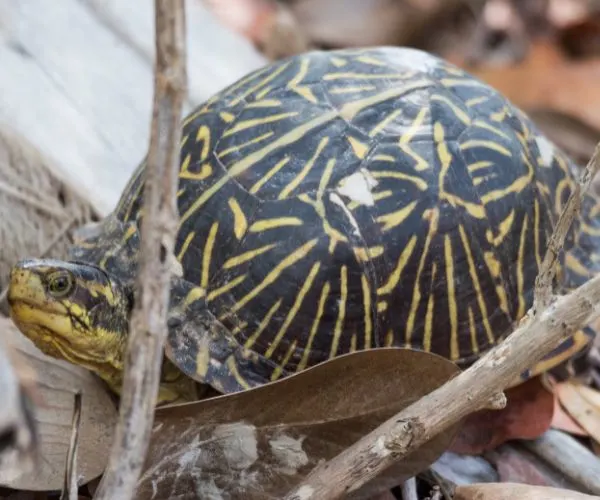
- Experience Level: Intermediate to Expert
- Family: Emydidae
- Scientific Name: Terrapine ornata
- Other Names: Box Tortoise, Western Box Turtle
- Adult Size: 4 to 5 inches (10 to 12.5 cm)
- Life Span: 30 to 40 years
- Average Price Range: $150 to $450
- Conservation Status: Near threatened
Also known as the Western Box turtle, this species lives in dry prairie lands, open plains, and occasionally in forests. They are one of the few box turtles that can withstand a dry environment.
Ornate Box turtles can completely enclose themselves in their shells because the plastron has a double hinge. They have a high domed carapace that is dark colored with yellow or orange markings. There is usually a broken yellow or orange line bisecting the carapace.
They tend to have a tan or yellow colored beak and similar colored spots on their skin.
The Ornate Box turtle is an opportunistic omnivore. They will eat nearly anything they come across. Fungi, grasses, flowers, fruits, insects, worms, spiders, caterpillars, and occasional carrion.
11. Three Toed Box Turtle

- Experience level: Intermediate
- Family: Emydidae
- Scientific Name: Terrapene carolina triunguis
- Other Names: N/A
- Average Adult Size: 4.5 – 6.5 inches
- Life Span: 70+ years
- Average Price Range: $140 – $430
- Conservation Status: Vulnerable
The Three Toed Box turtle has as you can assume, three toes on the hind legs. Some may have four toes though, so you can only go by the number of digits.
Like other Box turtles, they too can close themselves inside their shells. They have a high domed carapace but their coloration is more drab than other Box turtles.
The upper shell has a single ridge running along the middle. It’s olive colored or light brown with faint yellowish or orange lines. The plastron is dark yellow with brown smudges.
The skin of the Three Toed Box turtle is dark brown to black with brighter yellowish spots and blotches, with more yellow on the neck and chin.
Humid forests are where you’ll likely come across these turtles, but they can also be found in brushy fields. They need more humidity than Ornate box turtles and will sometimes submerge themselves in water to cool off and rehydrate.
Three Toed Box turtle adults are omnivorous, but they eat more vegetation than meat. The opposite is true for baby and juvenile turtles.
Pond Sliders in Kansas
12. Red Eared Slider

- Experience level: Beginner
- Family: Emydidae
- Scientific Name: Trachemys scripta elegans
- Common Name: Pond slider, Red-eared terrapin, Water slider
- Average Adult Size: 6 – 8 inches
- Life Span: 20 to 40 years
- Average Price Range: approximately $30 to $100
- Conservation Status: Least concern
The Red Eared Slider is found all over Kansas and is a native species of the state, but they have invaded many areas and set up strong populations elsewhere. These turtles are habitat generalists and can survive well in most waterways.
They were so popular in earlier decades that many unwanted pets were released into the wild. While this is usually a death sentence for most captive bred species, the Red Eared Slider has found a way to make it work to their advantage.
These turtles have an olive green to dark brown carapace with lighter color swirls and stripes. They have a fixed plastron that’s light yellow or tan with black spots.
Their skin starts off dark green but can darken over time. They have yellow to white stripes on their head, limbs, and tail. The tell-tale red marks behind their eyes are only found on this species.
Red Eared Sliders are excellent swimmers but prefer waters with slower moving currents. When basking, they will often overcrowd other species of turtles.
Aquatic vegetation, fish, crayfish, tadpoles, insects, and anything that moves that will fit in their mouths are potential food sources.
13. Yellow Bellied Slider
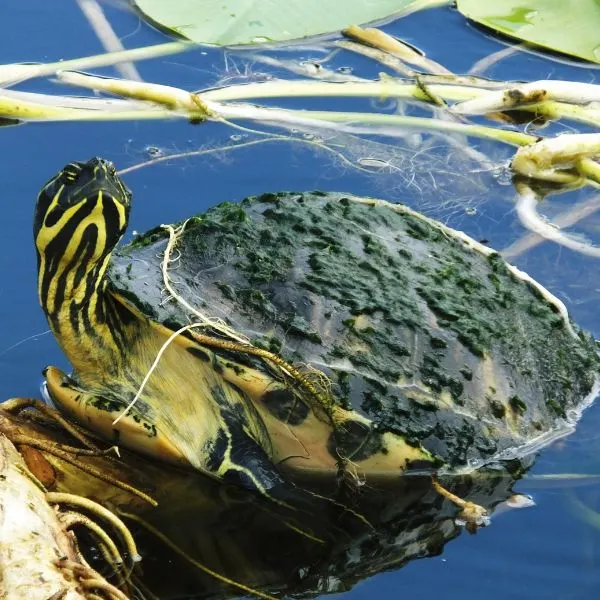
- Experience level: Beginner
- Family: Emydidae
- Scientific Name: Trachemys scripta scripta
- Other Names: Pond slider, Yellow slider
- Average Adult Size: 5 – 13 inches
- Life Span: 50 to 100 years
- Average Price Range: approximately $30 to $130
- Conservation Status: Least concern
Similar in color to Red Eared Sliders, the Yellow Bellied Slider has, of course, a yellow plastron, and the stripes on the skin are thicker and brighter and they have no red at all. Their carapace is very similar to the aforementioned Red Eared Slider.
Though highly aquatic, these turtles often leave the water to find nesting sites or find other sources of water. They prefer rivers, drainage ditches, streams, and ponds, but they will make due with nearly any type of waterway.
Not a native to Kansas, introduced populations have been found in Wyandotte County.
Adult Yellow Belly Sliders are mostly herbivorous.
Softshell Turtles in Kansas
14. Spiny Softshell Turtle
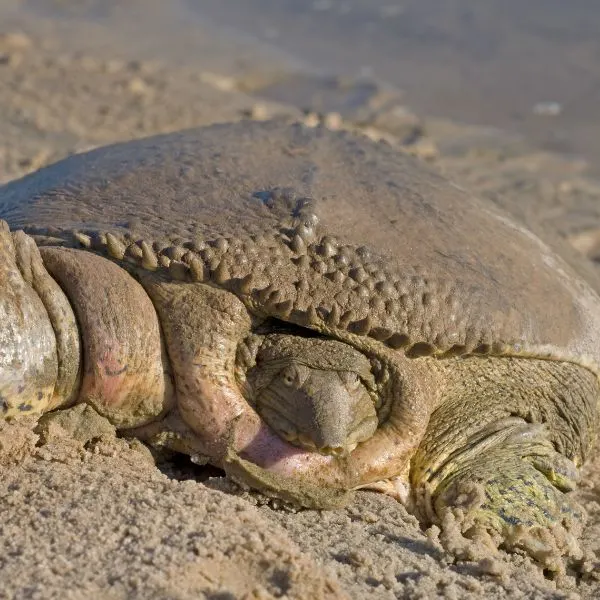
- Experience Level: Intermediate to Expert
- Family: Trionychidae
- Scientific Name: Apalone spinifera
- Other Names: N/A
- Adult Size: 5 to 9 ½ inches for males, 10 to 20 inches for females
- Life Span: Between 20 and 50 years
- Average Price Range: Between $20 and $120
- Conservation Status: Threatened in some areas
The Spiny Softshell turtle is a large, very aquatic turtle that doesn’t have a hard shell. Instead, they are covered with floppy leathery skin and cartilage. Because of this (I assume) they can be a very aggressive species.
Looking like a tan or brown, swimming, floppy frisbee, these turtles spend a lot of time at the bottom of the water. They prefer sandy or muddy bottoms where they can cover themselves and ambush prey when it comes close.
The Spiny Softshell doesn’t have thorns, instead, it has fleshy cones along the front ridge of the leathery shell.
Larger rivers and clear streams with sandy bottoms are their favorite places to live. In these habitats, they blend in very well. Softshell turtles are mostly carnivorous and will eat all types of aquatic fish and animals.
Female softshell turtles are frequently 2 to 3 times larger than males.
15. Smooth Softshell Turtle
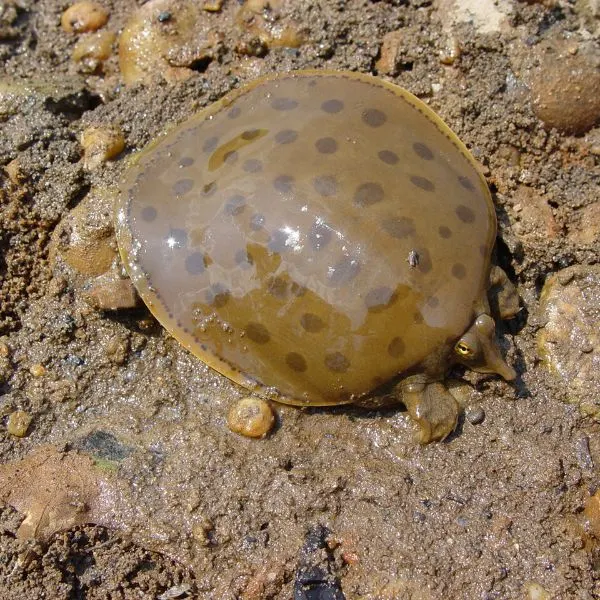
- Experience Level: Intermediate to Expert
- Family: Trionychidae
- Scientific Name: Apalone mutica
- Other Names: Spineless Softshell
- Adult Size: 4.5 to 14 inches
- Life Span: 25+ years
- Average Price Range: $40 to $60
- Conservation Status: Least concern
Smooth Softshell turtles look very similar to their spiny cousins, although they don’t have the lumps along the front edge of the shell. They may have darker spots on their carapace but they fade as time passes.
While these turtles look clumsy and awkward, they are actually extremely fast on land and water.
Because these turtles have so much skin and no hard shell, they can “breathe” through their skin while underwater. This allows them to stay submerged for nearly an hour before going to the surface for air.
These turtles have a long snout and a very long neck, so they often lay still in shallow waters and only stretch their necks up to get a breath of air.
Smooth Softshell turtles are mostly carnivorous. They will eat fish, crayfish, amphibians, and some insects. Occasionally they will add some supplemental vegetation to their diet.
Wrapping up
The varied climate and numerous bodies of water throughout the State of Kansas create perfect conditions for a number of both terrestrial and aquatic turtles to thrive. While you are out, be aware of your surroundings and you may see some of them in the wild.
If you decide you want a turtle as a pet, check your local laws to make sure you can own certain species. Then research and find reputable, licensed dealers that will sell you captive bred turtles. Taking them from the wild only harms the turtle and the environment.
While you are here, take a quick second to leave us a message. We love hearing from our readers. Until the next time!
Other nearby states
